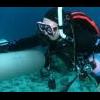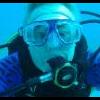
To Strobe or Not to Strobe
#1

Posted 19 June 2011 - 04:30 PM
TIA for your responses
#2

Posted 19 June 2011 - 05:07 PM
Regarding the blue issue, I think if the picture is a 'distance' shot, it's going to be blue. If you're taking pictures of things close-up, you can get the colors with internal or external flash, depending on the camera. When I'm in video mode, there isn't much color correction done by the camera, but brightly-colored fish do stand out on my videos....but there's a lot of blue in my videos!
It also depends a lot on post-production. If you shoot in RAW, you can fix a lot of things, including color, if you learn how to use Photoshop (expensive software!) or something similar. Not all cameras can shoot in RAW. If you shoot in JPG mode, regardless of the file size you pick to shoot in, you are limited in the corrections you can make in post-production. I can usually add a bit of red back in, or adjust the contrast or brightness, with JPG files. But, a blue shot is going to stay a blue shot with my camera.
Bottom line is, your budget and your purpose for taking photos will drive what you buy. If you want to take some memories home with you, start with a Canon. Get one that will be compatible with a strobe......so you can add trays, arms & strobes later if you want to.
Just my 2psi.
#3

Posted 19 June 2011 - 06:32 PM
:

E= pluribus Forum Enjoy the view. ,Do unto others:respect
#4

Posted 19 June 2011 - 07:30 PM
I should have added - I do have an external strobe and it's not through lack of one that I don't use it. I just don't like it for 95% of my shooting. I use the internal flash, but if you do that (as I recommend) make SURE the housing's flash diffuser is in place. You'll get very odd results if you use it without the diffuser, as the "nose" of the housing obscures the flash from the bottom of the subject in the close work you'll be doing under water.
Edited by peterbj7, 20 June 2011 - 08:36 AM.
#5

Posted 20 June 2011 - 07:59 AM
Dave
#6

Posted 20 June 2011 - 08:45 AM
I have several other items of photo processing software and I usually reach for them first. Although it's ultimately nowhere near as powerful or capable as PS, I far prefer using Roxio Photo Suite. In fact I commonly find myself using PS to interpret my RAW images and make basic adjustments, then switch to Roxio for the more artistic stuff.
That said, the latest version of Photoshop (12) has some extremely useful features once you learn how to use them.
#7

Posted 20 June 2011 - 07:15 PM
Dave
#8

Posted 21 June 2011 - 03:25 PM
I've been doing UW Photography for about a year and I'm just starting to get reasonably good results. What I have had very good results with is using my camera on Av or Tv settings (Aperture and Shutter priority, respectively), with a Magic Filter in place. This is a very simple natural light setup that is easy to learn. The Magic Filter is a small bit of specially colored acetate that compensates for the red loss at depth. You will get the best results from it at shallower depths with good sunlight, and you have to remember that any filter at all will trim down the light available to your camera. You have to be able to compensate with that by raising ISO (to a point, else you get other undesired effects), using larger apertures, or slower shutter speeds. I have been mostly happy with the results I get with mine, although there is a soft quality to the photos that I don't prefer.
Here is a link to photos I took in Fiji, all of them under natural light with a Blue Water Magic Filter, because my strobe was BROKEN!!! Bad thing to find out on a major trip like that, but because I'd done lots of natural light photos, all was not lost.
https://picasaweb.go...feat=directlink
You can compare these with the more crisp photos I got using the strobe this past weekend in Cozumel. You will also be able to tell that the strobe certainly enhances the backscatter effect from the particulate in the water, as a previous poster mentioned. I can clean that up in Adobe Lightroom or Photoshop Elements, but I didn't bother this time. Maybe later
https://picasaweb.go...feat=directlink
I personally feel that eventually you will want a strobe, but since full automatic mode isn't appropriate underwater (usually), it's a complication to add when you first start. You might have better results with a very capable camera like the G12 (or Canon S95, which is the latest version of what I shoot) and a Magic Filter. You just have to know your limits in terms of how deep you can go with what available light you have, and then whatever color you are still losing you can correct in post processing if you shoot RAW. That's what I do. Strobe eliminates a lot of that, but adds in a host of other things you have to master.
I know that's a lot of info, but I also know that when I introduced a strobe (way) too early in my learning process, it was frustrating, and I missed more shots than I got. Natural light will help you master the process before you add complexity.
Hope this helps,
Tina
#9

Posted 21 June 2011 - 07:55 PM
https://picasaweb.go...CLLnv5f2kZDpxwE
You can see in a couple of the pics where I had the strobe set to high. The sea horse, the sexy shrimp and the porceline crab are a bit over exposed but other wise I am happy with the results. I have a single strobe. The camera is set on auto focus, 100iso and force flash so that he strobe goes off every time. I also have a small focus light mounted on the housing and I found this very useful for night dives.
Jim
#10

Posted 22 June 2011 - 08:13 AM
I recently went on a trip and used a strobe for the first time. I am sold on it. I don't think I would take a camera down with out one now that I see the difference in my pics. I take mostly macro shots so I am very close to the subject. You can see my most recent attempts here.
https://picasaweb.go...CLLnv5f2kZDpxwE
You can see in a couple of the pics where I had the strobe set to high. The sea horse, the sexy shrimp and the porceline crab are a bit over exposed but other wise I am happy with the results. I have a single strobe. The camera is set on auto focus, 100iso and force flash so that he strobe goes off every time. I also have a small focus light mounted on the housing and I found this very useful for night dives.
Jim
Jim, these are great!
Tina
#11

Posted 22 June 2011 - 08:49 AM
But maybe the language has moved on and I'm behind the times. Anyone any views?
#12

Posted 22 June 2011 - 11:06 AM
I recently went on a trip and used a strobe for the first time. I am sold on it. I don't think I would take a camera down with out one now that I see the difference in my pics. I take mostly macro shots so I am very close to the subject. You can see my most recent attempts here.
https://picasaweb.go...CLLnv5f2kZDpxwE
You can see in a couple of the pics where I had the strobe set to high. The sea horse, the sexy shrimp and the porceline crab are a bit over exposed but other wise I am happy with the results. I have a single strobe. The camera is set on auto focus, 100iso and force flash so that he strobe goes off every time. I also have a small focus light mounted on the housing and I found this very useful for night dives.
Jim
Jim, these are great!
Tina
Thanks Tina. You motivated me on the Turks and Caicos trip to try and get better pictures.
Jim
#13

Posted 22 June 2011 - 11:10 AM
It's always been a puzzle to me why people call a device intended to provide a single flash of light at a particular instant a "strobe". As I have always understood it, a "strobe" by definition provides a series of flashes, great for a video camera but irrelevant to a stills camera. I find it particularly confusing as there are such things as 'strobes" that look superficially like external "flash" devices - I have one that in fact I only use for single flashes though it's capable of multi - and when p[eople use the term 'strobe" I have to interpret from the context what they mean. Anything to do with stills cameras refers to a single "flash".
But maybe the language has moved on and I'm behind the times. Anyone any views?
here is a basic explanation of the difference. Personally I don't care what they call them. If the manufactures all call them the same thing then the customers all know what they are talking about. I don't know any diver that carries a camera that does not know what one is talking about when referring to a strobe.
http://photo.tutsplu...ur-photography/
#14

Posted 22 June 2011 - 03:54 PM
I recently went on a trip and used a strobe for the first time. I am sold on it. I don't think I would take a camera down with out one now that I see the difference in my pics. I take mostly macro shots so I am very close to the subject. You can see my most recent attempts here.
https://picasaweb.go...CLLnv5f2kZDpxwE
You can see in a couple of the pics where I had the strobe set to high. The sea horse, the sexy shrimp and the porceline crab are a bit over exposed but other wise I am happy with the results. I have a single strobe. The camera is set on auto focus, 100iso and force flash so that he strobe goes off every time. I also have a small focus light mounted on the housing and I found this very useful for night dives.
Jim
Jim, these are great!
Tina
Thanks Tina. You motivated me on the Turks and Caicos trip to try and get better pictures.
Jim
Well thanks! And I am on a constant quest for exactly the same thing
Tina
#15

Posted 22 June 2011 - 05:05 PM
here is a basic explanation of the difference. Personally I don't care what they call them. If the manufactures all call them the same thing then the customers all know what they are talking about. I don't know any diver that carries a camera that does not know what one is talking about when referring to a strobe. http://photo.tutsplu...ur-photography/
Interesting, but I specifically think the writer is wrong. He says quite directly that a flash is always mounted on a camera, and that once it is detached it becomes a strobe. That's not so - a flash (also known as a speedlight) if not built in to the camera can be positioned anywhere on or off the camera, and it doesn't thereby switch from between being a flash or a strobe. I use flashes (speedlights) on and off my camera, and at least one of those I can use underwater. I also have a strobe intended for underwater use, but that isn't a speedlight - it's designed so it can give multiple flashes if called on to do.
In stills photography there's rarely any confusion so I suppose it doesn't particularly matter. But get into video and it makes a great deal of difference. A strobe is not the same thing as a flash/speedlight.
Reading on in that article he starts talking about Alien Bees. AB's are neither strobes nor flashes, but permanent-on lamps. They are generally used in a studio, but they can be used on location given an adequate power source. But they don't strobe - they are on for the duration they are switched on. Some have the ability to be on at low power for framing and positioning, then turned up to full power for shooting. But that is a manual process not triggered by the camera. But only for use on land.
To complicate the matter further, speedlights can be used in a similar way when combined with co-located low power lights, usually LED. All positioning is done with the LEDs on, then the camera triggers the flash(es). Also only for land use.
A "strobe" is so named because it "strobes". As Wikipedia says "A strobe light or stroboscopic lamp, commonly called a strobe, is a device used to produce regular flashes of light. It is one of a number of devices that can be used as a stroboscope. The word originated from the Greek strobos, meaning 'act of whirling.'" The OED gives a similar definition, and I daresay Webster's does the same.
Edited by peterbj7, 22 June 2011 - 05:18 PM.
0 user(s) are reading this topic
0 members, 0 guests, 0 anonymous users

















